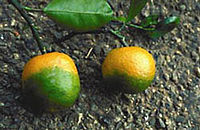
Photo from wikipedia
Protecting crop yields is the most important aspect of agricultural production, and one of the important measures in preserving yields is the control of crop pests and diseases; therefore, the… Click to show full abstract
Protecting crop yields is the most important aspect of agricultural production, and one of the important measures in preserving yields is the control of crop pests and diseases; therefore, the identification of crop pests and diseases is of irreplaceable importance. In recent years, with the maturity of computer vision technology, more possibilities have been provided for implementing plant disease detection. However, although deep learning methods are widely used in various computer vision tasks, there are still limitations and obstacles in practical applications. Traditional deep learning-based algorithms have some drawbacks in this research area: (1) Recognition accuracy and computational speed cannot be combined. (2) Different pest and disease features interfere with each other and reduce the accuracy of pest and disease diagnosis. (3) Most of the existing researches focus on the recognition efficiency and ignore the inference efficiency, which limits the practical production application. In this study, an integrated model integrating single-stage and two-stage target detection networks is proposed. The single-stage network is based on the YOLO network, and its internal structure is optimized; the two-stage network is based on the Faster-RCNN, and the target frame size is first clustered using a clustering algorithm in the candidate frame generation stage to improve the detection of small targets. Afterwards, the two models are integrated to perform the inference task. For training, we use transfer learning to improve the model training speed. Finally, among the 37 pests and 8 diseases detected, this model achieves 85.2% mAP, which is much higher than other comparative models. After that, we optimize the model for the poor detection categories and verify the generalization performance on open source datasets. In addition, in order to quickly apply this method to real-world scenarios, we developed an application embedded in this model for the mobile platform and put the model into practical agricultural use.
Journal Title: Plants
Year Published: 2023
Link to full text (if available)
Share on Social Media: Sign Up to like & get
recommendations!